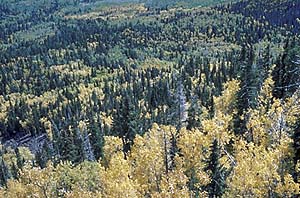
 Biotic
Communities of the Colorado Plateau
Biotic
Communities of the Colorado Plateau
The Community Concept
 |
|
Mixed aspen, spruce, and Douglas fir forest, south slope of Boulder Mt. on Utah's Aquarius Plateau. Photo © RayWheeler. |
In the late 1880s, C. Hart Merriam surveyed the plant life of the San Francisco Peaks near Flagstaff, Arizona, for the federal Biological Survey. Merriam observed that from the top of the Peaks to the bottom of Grand Canyon, vegetative communities tended to occur along an elevation range. He sought to understand what factors influenced the distribution of the region’s vegetation, and began to categorize distinctive vegetational belts or "life zones."
Ecologists and biogeographers still categorize ecological communities based on dominant vegetation, but modern classification systems are more complex than Merriam's. In this website we follow the "biotic communities" concepts of David E. Brown, which include both plant and animal life. (See reference below; for a list of biotic communities of the Colorado Plateau, see the left-side menu). For example, Abert's squirrel can be readily linked to its habitat of ponderosa pine forest while pinyon jays are primarily adapted to the region's expansive pinyon-juniper woodlands.
Modern ecology holds that all ecological communities are composed of individual species whose ecological tolerances happen to overlap, forming what appears to be a specific zone of vegetation. In other words, individual species have over time evolved their own ecological tolerances to different factors such as precipitation, soil types, shade, fires, temperature, etc. Though gambel oak and ponderosa pine commonly live in the same biotic community, if environmental conditions were to change each of these species would respond individualistically, and perhaps would end up in new, different communities. Paleoecological studies on the Colorado Plateau indicate that limber pine may have been one of the region’s lower elevation pines in the past, living among juniper and pinyon-pine in a niche that is today occupied by ponderosa pine. Conditions have since changed, and limber pine is now predominantly seen growing in the subalpine conifer forest at high elevations. The pine has found a new niche, and is no longer a part of modern pinyon-juniper woodland or a ponderosa pine forest biotic communities.
For more information, see:
C Hart Merriam and the Life Zones Concept
Map of
the Biotic Communities of the Greater Grand Canyon Region
Resource:
Brown, D. E. 1994. Biotic communities of the Southwestern United States and northwestern Mexico. University of Utah Press, Salt Lake City, 342 pp.
Research:
Paleobotany and Paleoclimate of the Southern Colorado Plateau. The biota of the Colorado Plateau during the middle (50,000-27,500 B.P.) and late (27,500-14,000 B.P.) Wisconsin time periods was dramatically different from that seen today. Differences were primarily a result of major climate changes associated with the last major glacial period. This site examines the environment of the southern plateau during this time. Adapted by R. Scott Anderson from his journal article.
Packrat Midden Research in the Grand Canyon. On the Colorado Plateau the ice age (Pleistocene) vegetation of the Grand Canyon has been determined through the analysis of plant fossils preserved in caves and fossil packrat middens. Large changes occurred as the most recent ice age ended and the Holocene era began. Adapted by Kenneth L. Cole from his journal article.
